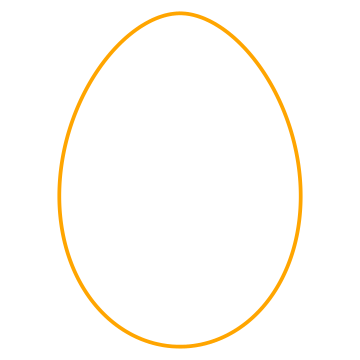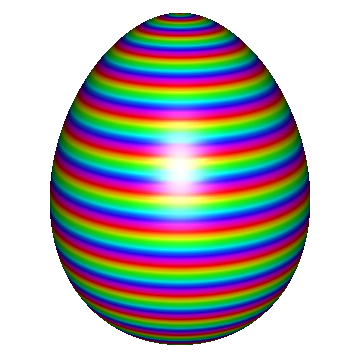Draw Easter Eggs
This article shows you how to draw an egg with R. It’s probably the simplest way to create an
animated figure using the animation package. The only function
used in this package is ani.pause().
Let’s get started!
A simple egg
The equations that define an egg are:
In the figure below, let’s swap the x axis and y axis for an egg in the vertical direction.
t = seq(-pi, pi, by = 0.01)
H = 1
x = H * 0.78 * cos(t/4) * sin(t)
y = -H * cos(t)
par(mar = rep(0, 4))
plot(x, y, type = "l", xlim = c(-1, 1), ylim = c(-1, 1), asp = 1,
col = "orange1", lwd = 5, axes = FALSE)

We need a Rotation matrix to draw the rotating egg:
The ani.pause() function is called to pause for a time interval (by default specified in
ani.options('interval')) and flush the current device. We draw a egg with with different angles
in 30 images, and you will see the egg rotating below:
library(animation)
egg_rotation = function(H = 1, angle = seq(0, pi * 2, length = 30),
pos = c(0, 0)) {
t = seq(-pi, pi, by = 0.01)
for (i in 1:length(angle)) {
x = H * 0.78 * cos(t/4) * sin(t)
y = -H * cos(t)
# Rotation matrix
x1 = cos(angle[i]) * x - sin(angle[i]) * y + pos[1]
y1 = sin(angle[i]) * x + cos(angle[i]) * y + pos[2]
cols = colors()
flag = sample(1:length(cols), 1)
plot(x1, y1, type = "l", xlim = c(-1, 1), ylim = c(-1, 1),
asp = 1, col = cols[flag], lwd = 8, axes = FALSE)
ani.pause(0.1)
}
}
par(mar = rep(0, 4))
egg_rotation()
Another example:
library(animation)
egg = function(h = rnorm(1), angle = rnorm(1), pos = rnorm(2)) {
t = seq(-pi, pi, by = 0.01)
for (i in 1:10) {
H = h - h/10 * i
x = H * 0.78 * cos(t/4) * sin(t)
y = -H * cos(t)
# Rotation matrix
x1 = cos(angle) * x - sin(angle) * y + pos[1]
y1 = sin(angle) * x + cos(angle) * y + pos[2]
cols = colors()
flag = sample(1:length(cols), 1)
plot(x1, y1, type = "l", xlim = c(-1, 1), ylim = c(-1, 1),
asp = 1, col = cols[flag], lwd = 8, axes = FALSE)
ani.pause(0.1)
}
}
par(mar = rep(0, 4))
set.seed(123)
for (j in 1:10) {
egg()
ani.pause(1)
}
3D eggs
If you want to draw a 3D egg. The rgl package can help you do it. The 3D egg is just a perturbation of a sphere. The function is:
Here we set $c=0.2, b=0.3$.
meshgrid <- function(a, b) {
list(x = outer(b * 0, a, FUN = "+"), y = outer(b, a * 0, FUN = "+"))
}
library(rgl)
c = 0.2
b = 1.7
theta = seq(0, 2 * pi, length = 40 * 4)
phi = seq(0, pi, length = 40 * 4)
theta1 = meshgrid(theta, phi)$x
phi2 = meshgrid(theta, phi)$y
x = (1 + c * phi2) * sin(phi2) * cos(theta1)
y = (1 + c * phi2) * sin(phi2) * sin(theta1)
z <- b * cos(phi2)
surface3d(x, y, z, color = rainbow(10))
par3d(zoom = 0.7)

References
- This article was reproduced from vistat
- Equation of Egg Shaped Curve II
- Mathematically defined Easter eggs